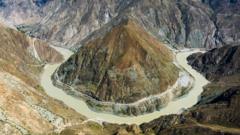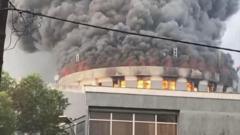A Chinese initiative to build the Gangtuo dam in Tibet has sparked unprecedented protests amid claims of government brutality, highlighting ongoing tensions surrounding development in sensitive regions.
Tibetan Protests Erupt Over Planned Dam Project Amid Crackdown

Tibetan Protests Erupt Over Planned Dam Project Amid Crackdown
Rare protests in Tibet against a controversial dam project led to a severe government crackdown, with numerous arrests and allegations of brutality.
Article Text:
A controversial plan to construct the Gangtuo dam on the Jinsha river has ignited unprecedented protests in Tibet this year, prompting a severe crackdown from the Chinese authorities. These protests, which are exceedingly rare in the region due to Beijing's stringent control, have raised international concerns about human rights violations and the preservation of Tibetan culture.
According to reports by the BBC, hundreds of Tibetans took to the streets earlier this year to oppose the dam, resulting in a substantial government response that included widespread arrests and allegations of physical abuse. The planned dam, which would have a detrimental impact on the local community by submerging culturally significant sites, has been met with increasing resistance from residents who fear displacement and loss of heritage.
As the protests grew, the Chinese government implemented a harsh crackdown, silencing dissent by detaining hundreds of participants and restricting communication to the outside world. Eyewitness accounts and verified video footage depict scenes of protesters being beaten and arrested, as officials launched raids on homes to quell further demonstrations.
Sources, who spoke to the BBC on the condition of anonymity due to safety concerns, describe a tense atmosphere in which villagers and monks engaged in peaceful protests, pleading with authorities to halt the evictions linked to the dam's construction. Despite their lawful appeals, reports of intimidation and violence emerged, with many detainees reportedly enduring severe beatings during their captivity.
The Gangtuo dam, pending approval since 2012, is the latest in a series of dams in Tibetan regions aimed at meeting China's growing energy demands. Critics argue that the project's development disregards local consent and threatens the environment, with previous relocations of Tibetans raising alarms about cultural erosion and inadequate compensation.
Human rights groups have condemned the Chinese government, asserting that such development projects exploit Tibetan land and violate the rights of its people. Despite claims of comprehensive consultation regarding the dam’s construction, many locals report a lack of meaningful dialogue and insufficient information provided in their native language.
In response to global concerns, the Chinese government has maintained that any relocations are carried out with community consent and that residents are offered support and new housing. However, numerous accounts contradict this narrative, documenting inadequate compensation and disruption of traditional lifestyles crucial to Tibetan identity.
As the international community watches closely, the situation in Tibet serves as a reminder of the delicate balance between development and cultural preservation. Observers argue that the ongoing dam projects encapsulate an exploitation model often deemed necessary for economic progress yet frequently at odds with the rights of marginalized communities.
The BBC’s investigation continues to shed light on the evolving dynamics in Tibetan territories, urging a broader conversation about the implications of development and the respect for human rights in these sensitive regions. With increased surveillance and restrictions in place following the protests, the future of Tibetans remains precarious, raising questions about the true cost of China's ambitious energy goals.
A controversial plan to construct the Gangtuo dam on the Jinsha river has ignited unprecedented protests in Tibet this year, prompting a severe crackdown from the Chinese authorities. These protests, which are exceedingly rare in the region due to Beijing's stringent control, have raised international concerns about human rights violations and the preservation of Tibetan culture.
According to reports by the BBC, hundreds of Tibetans took to the streets earlier this year to oppose the dam, resulting in a substantial government response that included widespread arrests and allegations of physical abuse. The planned dam, which would have a detrimental impact on the local community by submerging culturally significant sites, has been met with increasing resistance from residents who fear displacement and loss of heritage.
As the protests grew, the Chinese government implemented a harsh crackdown, silencing dissent by detaining hundreds of participants and restricting communication to the outside world. Eyewitness accounts and verified video footage depict scenes of protesters being beaten and arrested, as officials launched raids on homes to quell further demonstrations.
Sources, who spoke to the BBC on the condition of anonymity due to safety concerns, describe a tense atmosphere in which villagers and monks engaged in peaceful protests, pleading with authorities to halt the evictions linked to the dam's construction. Despite their lawful appeals, reports of intimidation and violence emerged, with many detainees reportedly enduring severe beatings during their captivity.
The Gangtuo dam, pending approval since 2012, is the latest in a series of dams in Tibetan regions aimed at meeting China's growing energy demands. Critics argue that the project's development disregards local consent and threatens the environment, with previous relocations of Tibetans raising alarms about cultural erosion and inadequate compensation.
Human rights groups have condemned the Chinese government, asserting that such development projects exploit Tibetan land and violate the rights of its people. Despite claims of comprehensive consultation regarding the dam’s construction, many locals report a lack of meaningful dialogue and insufficient information provided in their native language.
In response to global concerns, the Chinese government has maintained that any relocations are carried out with community consent and that residents are offered support and new housing. However, numerous accounts contradict this narrative, documenting inadequate compensation and disruption of traditional lifestyles crucial to Tibetan identity.
As the international community watches closely, the situation in Tibet serves as a reminder of the delicate balance between development and cultural preservation. Observers argue that the ongoing dam projects encapsulate an exploitation model often deemed necessary for economic progress yet frequently at odds with the rights of marginalized communities.
The BBC’s investigation continues to shed light on the evolving dynamics in Tibetan territories, urging a broader conversation about the implications of development and the respect for human rights in these sensitive regions. With increased surveillance and restrictions in place following the protests, the future of Tibetans remains precarious, raising questions about the true cost of China's ambitious energy goals.




















